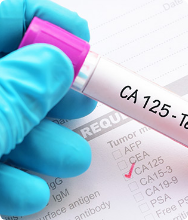
Book a Consultation
Thank you!
Your form has been sent successfully.

The ovaries form a part of the female reproductive system. There are two ovaries–one located on each side of the uterus. The fallopian tubes are a series of small ducts that connect the ovaries to the uterus. The peritoneum is a tissue that lines the abdomen and most of its organs. The tissue surrounds the uterus, bladder, rectum, and ovaries. These are the areas in which ovarian cancer develops. Ovarian, fallopian tube, and peritoneal cancers are related and are generally treated in the same manner. These cancers begin when healthy cells mutate and grow abnormally, forming a mass known as a tumor, that can be malignant or benign.
According to recent research, the majority of these types of cancers are high-grade serous cancers that begin in the tip or outer end of the fallopian tubes. It then spreads to the surface of the ovaries. Different types of ovarian/fallopian tube cancers include the following:

Serous membranes line and cover internal body organs like the heart, abdominal cavity, etc. A thin layer of serous fluid secreted by the epithelium covers the serous membranes. Epithelial cancers account for 85 to 90 percent of ovarian/fallopian tube cancers. They are either HGSC (high-grade serous cancer) or LGSC (low-grade serous cancer).
Serous, endometrioid, clear cell, mucinous, mixed tumors, and several rare cancers, such as Brenner tumors, are the most common types of epithelial tumors.
This is an uncommon type of ovarian cancer. It develops in the ovaries' egg-producing cells. Germ cell malignancies are most common between the ages of 10 and 29. The types of germ cell tumors include dysgerminomas, immature teratomas, endodermal sinus tumors, and embryonal carcinomas.
This tumor develops in the connective tissue cells that hold the ovaries together, known as granulosa and theca cells.
Most ovarian cancers begin in the fallopian tube. Virtually all of these are high-grade serous cancers (HGSC).
Ovarian/ fallopian tube and peritoneal cancer symptoms may include the following:
 Pain or swelling in the abdomen or pelvis
Pain or swelling in the abdomen or pelvis
 Bloating
Bloating
 Indigestion
Indigestion
 Constipation
Constipation
 Difficulty eating
Difficulty eating
 Feeling full quickly
Feeling full quickly
 Frequent urination
Frequent urination
 Tiredness
Tiredness
 Back pain
Back pain
 Irregular menstruation
Irregular menstruation
 Vaginal discharge
Vaginal discharge
 Pain during sexual intercourse
Pain during sexual intercourse
The treatment for ovarian/ fallopian tube and peritoneal carcinoma is the same. The treatment recommendations depend on various factors, including the type, stage, and grade of the disease. Possible treatment options are as follows:

Surgery is often needed to find out the extent of the disease. There are several surgical options for this disease: salpingo-oophorectomy (removal of the ovaries and fallopian tubes), hysterectomy (removal of the uterus), and debulking surgery (for advanced cancer cases).
This therapy uses drugs to kill cancer cells. The American Society of Clinical Oncology (ASCO) and the Society of Gynecologic Oncology (SGO) has a joint clinical practice guideline on using neoadjuvant chemotherapy to treat advanced ovarian / fallopian tube cancer.
This treatment targets the cancer’s specific genes, proteins, or the tissue environment contributing to abnormal cell growth. Some targeted therapy drugs are directed at specific genes for ovarian / fallopian tube cancer.
Radiation therapy is not used as the first treatment for this disease. Following chemotherapy, it may be used to treat some people with stage I or II clear cell ovarian cancer. It could also be used to treat ovarian / fallopian tube cancer that has spread to other body parts.
Early detection is often difficult for ovarian, fallopian tubes, and peritoneal cancer. There are no effective screening methods, and many benign conditions may look cancerous and vice versa in some tests.
To diagnose ovarian/ fallopian tube cancer, the following tests may be used:

The doctor will check the uterus, vagina, ovaries, bladder, and rectum for any unusual changes, such as a mass, during this exam.

This blood test measures a substance called CA-125. It is found in higher levels in people with ovarian / fallopian tube cancer.

It is a procedure to examine the vagina, uterus, and ovaries through an ultrasound probe.

Imaging tests such as a CT scan or MRI scan can be used to measure the tumor’s size and find out the degree to which cancer has spread.

The removal of a small amount of tissue for examination is known as biopsy. They are often done as part of the first surgery for this cancer.
Our ovarian / fallopian tube cancer specialists are dedicated to providing excellent patient care by prescribing effective and individualized treatment plans. We have some of Florida's most experienced providers on our team. Our professionals strive to create a positive environment for patients and their families throughout their cancer journey.
The following are our providers who you can consult at ACTC:

MD, Hematology & Oncology

MD, Ph.D., Hematology/ Medical Oncology

MD, Radiation Oncologist

The clinical team of ACTC has more than two decades of cancer treatment experience. We are committed to providing patients with personalized treatments at every stage. Our facility is equipped with an infusion room, medical and radiation oncology exam rooms, a treatment vault, and cutting-edge diagnostic technology for ovarian, fallopian tube, and peritoneal cancer treatment.
Schedule a consultation by calling
 352-345-4565
352-345-4565
Cancer that has spread to the peritoneum outside the pelvis is said to be in stage IIIC.
If not detected early, most cases of ovarian cancer will follow a similar path: from the pelvis to more distant parts of the abdomen and peritoneal cavity, lymph nodes, and the liver.
The exact cause of peritoneal cancer is unknown, but the process begins when a series of mutations in peritoneal cells results in out-of-control growth. This could be due to previous cancer that has spread to the peritoneum or another type of cancer known as primary peritoneal cancer.
Schedule a consultation by calling
 352-345-4565
352-345-4565